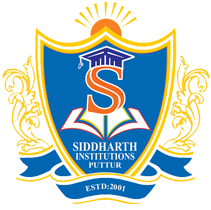




DEPARTMENT OF ELECTRONICS & COMMUNICATION ENGINEERING
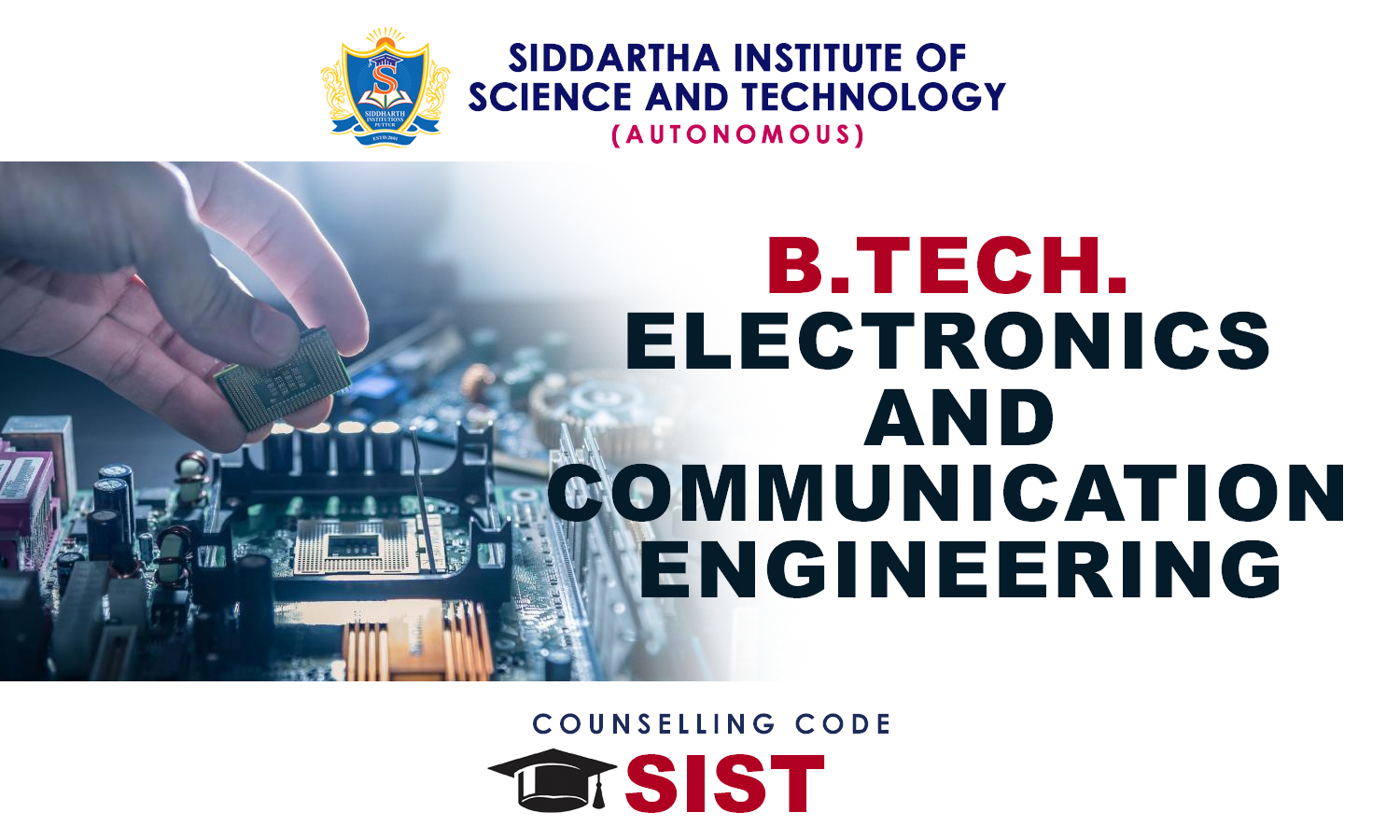
ABOUT ECE DEPARTMENT
The Department of Electronics & Communication Engineering (ECE) is an evergreen domain that serves the needs of the society starting from the basic home appliances to the highly sophisticated Medical devices; terrestrial and extra terrestrial communication systems like Telephones, Cellular phones, Television, Fiber Optic Communication system, RADAR and Satellite Communication system. The sub domain technologies like VLSI, Embedded systems, Signal and Image processing, Sensors and Transducers and Computer Networks find wide scope in the areas of Defence technology, Consumer electronics and Internet of Things (IoT).
The Department of Electronics and Communication Engineering, established in 2008, is one of the most dynamic departments of Siddartha Institute of Science and Technology [SISTK] with intake of 240. The department of Electronics and Communication Engineering has been accredited by National Board of Accreditation [NBA] for its eminence.
The objective of ECE@SISTK is to create world-class engineering specialists capable of influencing society and achieving global recognition. The department's well-qualified faculty's teaching and research experience will go a long way toward nurturing students' enthusiasm for technology. Research cultivation in the department will also encourage our students to flourish at different stages by creating solutions to societal issues. In addition to being academically sound and disciplined, ECE students at SISTK are also active in a variety of professional clubs’ and professional bodies that organize various events.
The potential graduates of the ECE department have wide placement scope in the core industries, software field and research position in organizations viz., ISRO, DRDO, BARC, HAL, BSNL, NARL, BHEL and BEL etc. along with wide range of applications in industries such as defence, consumer electronics, and the Internet of Things (IoT). With high industry demand and excellent employment chances, the ECE Department at SISTK stands tall and proud.
VISION & MISSION OF THE DEPARTMENT
Vision
To prepare engineers, proficient to meet the needs of current technological advancements in the field of Electronics and communication engineering by imparting quality teaching with due attention to progressive needs of the industry in academics and research.
M2: To strive towards efficient industry-institute interaction in the recent trends of communication techniques and imaging modalities through education and R&D activities.
M3: : To inculcate a mind of continuous learning while providing ethical and value based education by promoting activities for addressing the societal needs.
The following are the program outcomes of Engineering Graduates:
PO1: Engineering knowledge: Apply the knowledge of mathematics, science, engineering fundamentals, and an engineering specialization to the solution of complex engineering problems.PO2: Problem analysis: Identify, formulate, review research literature, and analyze complex engineering problems reaching substantiated conclusions using first principles of mathematics, natural sciences, and engineering sciences.
PO3: Design/development of solutions: Design solutions for complex engineering problems and design system components or processes that meet the specified needs with appropriate consideration for the public health and safety, and the cultural, societal, and environmental considerations.
PO4: Conduct investigations of complex problems: Use research-based knowledge and research methods including design of experiments, analysis and interpretation of data, and synthesis of the information to provide valid conclusions.
PO5: Modern tool usage: Create, select, and apply appropriate techniques, resources, and modern engineering and IT tools including prediction and modeling to complex engineering activities with an understanding of the limitations.
PO6: The engineer and society: Apply reasoning informed by the contextual knowledge to assess societal, health, safety, legal and cultural issues and the consequent responsibilities relevant to the professional engineering practice.
PO7: Environment and sustainability: Understand the impact of the professional engineering solutions in societal and environmental contexts, and demonstrate the knowledge of, and need for sustainable development.
PO8: Ethics: Apply ethical principles and commit to professional ethics and responsibilities and norms of the engineering practice.
PO9: Individual and team work: Function effectively as an individual, and as a member or leader in diverse teams, and in multidisciplinary settings.
PO10: Communication: Communicate effectively on complex engineering activities with the engineering community and with society at large, such as, being able to comprehend and write effective reports and design documentation, make effective presentations, and give and rCSEive clear instructions.
PO11: Project management and finance: Demonstrate knowledge and understanding of the engineering and management principles and apply these to one’s own work, as a member and leader in a team, to manage projects and in multidisciplinary environments.
PO12: Life-long learning: Recognize the need for, and have the preparation and ability to engage in independent and life-long learning in the broadest context of technological change.
The Program Educational Objectives of the Electronics and Communication Engineering are:
PEO1: Posses basic professional electronic engineering skills that make the student confident to develop sophisticated electronic equipments to fulfill the needs of the living beings.PEO2: Inculcate analytical mind to realize the importance of the advances in communication techniques through professional development, hands-on training and industry internship that establishes the interest for higher studies and to become a pioneering professional.
PEO3: To exhibit good technical communication skills, ethical and social value in their professional career, to lead a team with good leadership qualities for serving the society to look ahead.
The following are the Program Specific Outcomes of Engineering Graduate:
PSO1: An ability to understand the concept and the applications in the field of Communication, Embedded system and Semiconductor technology.PSO2: Should be able to develop and Test technological advancements related to Signal processing, Embedded and Communication systems.
PSO3: Should have the capability to analyze and design different modern tools to arrive at solutions for societal and real world problem.
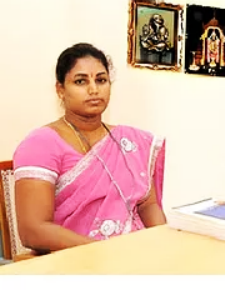
Dr. B. Saroja - Professor & HOD
Dr. B. Saroja earned her Engineering Doctorate in the discipline of Image Processing from Chennai's Vel Tech Rangarajan Dr. Sagunthala R & D Institute of Science and Technology. She holds a Master's degree in Applied Electronics and a Bachelor's degree in Electronics and Communication Engineering. Additionally, she was recognised by the University Grants Commission for her lectureship in 2012.
She has been the Head of the ECE department for the last decade and has 15+ years of teaching experience in the Department of Electronics and Communication Engineering. Additionally, she has held numerous Academic Administration posts in a variety of engineering colleges. Her areas of research include, but are not limited to, Communication Systems, Image Processing, Wireless Sensor Networks, and VLSI. Her research and scientific contributions have been indexed in the UGC, WoS, Scopus, and SCI databases. In addition, she owns numerous IPRs to her name. She holds various professional body memberships viz., ISTE, IAENG, UACEE, IAETSD and ISRD. The development of the Department-Institution has profited from her wide ability to timely devise workshops, seminars, and professional development programmes for students and other faculty colleagues.
HoD’s Message about ECE
As HoD, I trust that my faculty and staff, as well as curious, ambitious students, are capable of making significant contributions to the nation's development and representing the country on a global stage. ECE@SISTK has become a sign for high-quality placements that highlight our academic and extracurricular achievements.
I cordially greet you to the Electronics and Communication Engineering Department, where you will find an undergraduate programme that is always at its best. My colleagues and I are certain that students’ time at ECE-SISTK will enable themselves to shine in a successful and distinguished career.
Become familiar with Department of Electronics and Communication Engineering (ECE) @ SISTK visit us on https://www.sistkece.org/
Board of Studies Members (ECE)
DEPARTMENT MOU'S
| S.No. | MOU's | Year of Mou |
|---|---|---|
| 1. | Central Institute of Tool Design (CITD) | 2014 |
| 2. | INTEL Technology India Private Limited, Bangalore | 2016 |
| 3. | International Incubation Center | 2016 |
| 4. | Skill Development Centre | 2016-2017 |
| 5. | Microsoft Innovation Centre | 2016 |
| 6. | SIEMENS | 2016 |
| 7. | LEKHA WIRELESS SOLUTIONS | 2016 |
| 8. | RLT Instrumentation Pvt Ltd | 2016 |
Board of Studies Members (ECE)
| S.No | Member Name | Designation / Organization | Role of Bos | |
|---|---|---|---|---|
| 1 | Dr. B. Saroja | Professor & H.O.D | Chairman | |
| 2 | PDr. P. Chandrasekar | Professor | Member | |
| 3 | Dr. Basavaraj G Kudamble | Professor | Member | |
| 4 | Dr. K. Gunasekaran | Professor | Member | |
| 5 | Dr. S. M. Sharma | Professor | Member | ,|
| 6 | Mr. D. Jayanayudu | Associater Professor | Member | |
| 7 | Mr. L. Sivaprasad | Associate Professor | Member | |
| 8 | Dr. S. Swarnalatha | Professor Department of ECE, Sri Venkateswara University, Tirupati | Member | |
| 9 | Dr. G. Nagarajan | Professor EDepartment of ECE, Pondichery University, Puducherry | Member | /td>Member |
| 10 | Mr. Kiran Dhananjayan | Program Manager, TCS | Member | |
| 10 | Ms. Harshitha Jangamsetty | Engineer, L & T Technology Services | Member |
REGULATIONS & SYLLABUS
ECE DEPARTMENT LABORATORIES
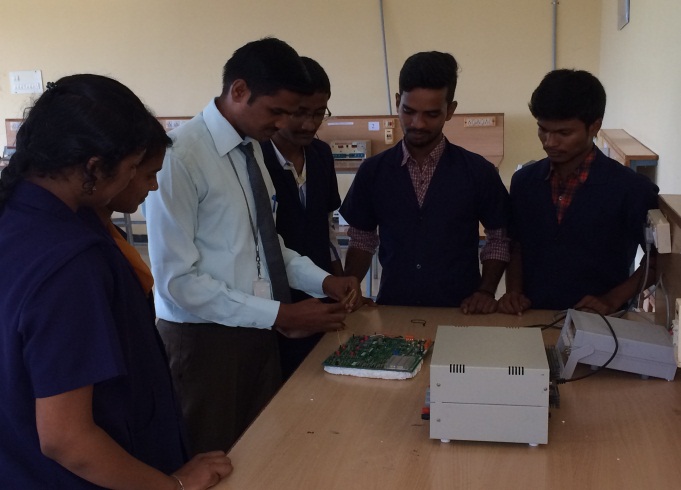
IC Applications & Pulse and Digital Circuits Lab:
Pulse and Digital Circuits lab is an extension to the Electronic Devices and Circuits lab, and is used to test the working performance of different digital circuits and oscillators using CROs (Cathode Ray Oscilloscopes). IC Applications lab is also equipped with hardware kits and mainly focuses on types of ICs used in electronic circuits and their functioning. In this lab students will observe the responses of different circuits using different ICs.
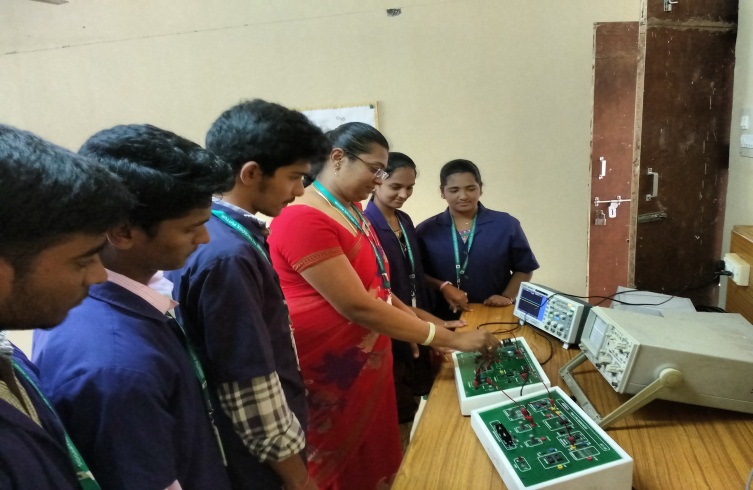
Communications Lab:
Analog Communications lab is completely equipped with the hardware kits. This lab provides the information about the different types of modulators and demodulators used and types of techniques used for the processing of the analog (continuous) signals. Digital Communications lab trains the students in different techniques used for the processing and communication of digital (discrete) signals and the type of circuits used for modulating and demodulating the digital signals.
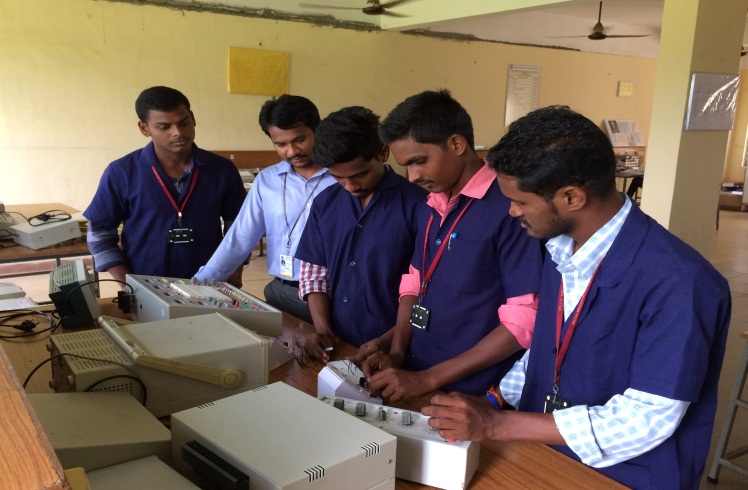
Electronic Devices and Circuits Lab:
This is the basic laboratory for the ECE students and in this lab students get the information regarding the basic resistors, transistors. This laboratory trains the students in working with different amplifiers and oscillators. It provides a good foundation on electrical and electronic components to the students in the nascent years.
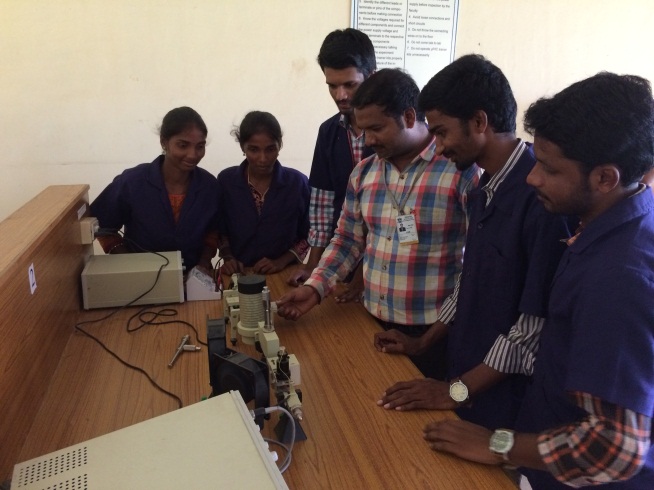
Microwave and Optical Communications Lab:
Associated with the microwave components and Optical fiber communication, this lab trains the students in operating of different microwave components like Attenuators, Directional couplers, etc. This lab also focuses on the working of optical fibers and their performance.
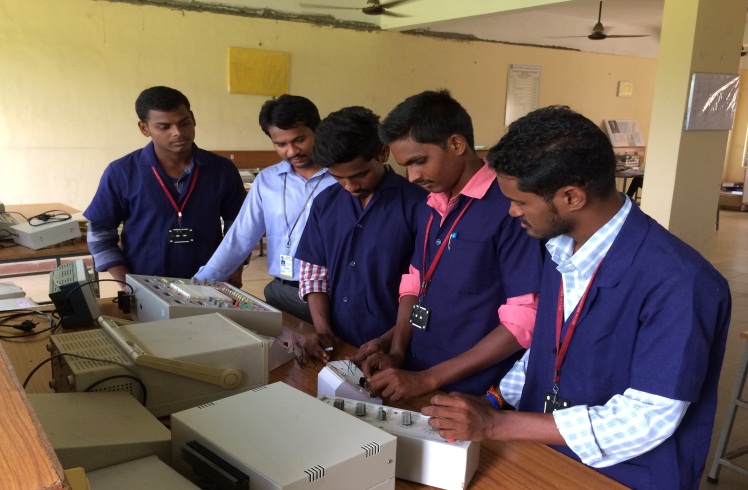
Electronic Circuit Analysis Lab:
In this lab, all the computers are installed specifically with the modelsim software. The students get trained in developing electronic circuits using modelsim and simulate (run) them. And they can directly observe the responses of different circuits by simulating.
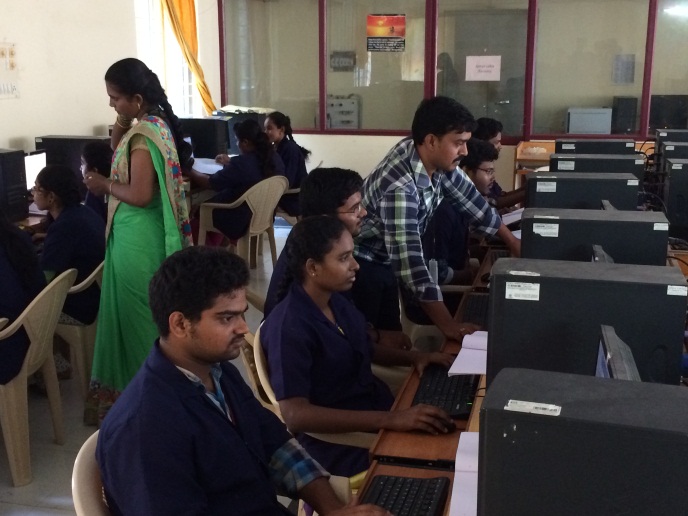
Digital Signal Processing Lab:
This lab is equipped with computers which have MATLAB 7.1 version installed in them. In this lab, students mainly focus on designing and developing different types of filters. This lab is also useful to compute the transformations such as DFT, FFT of the signals.
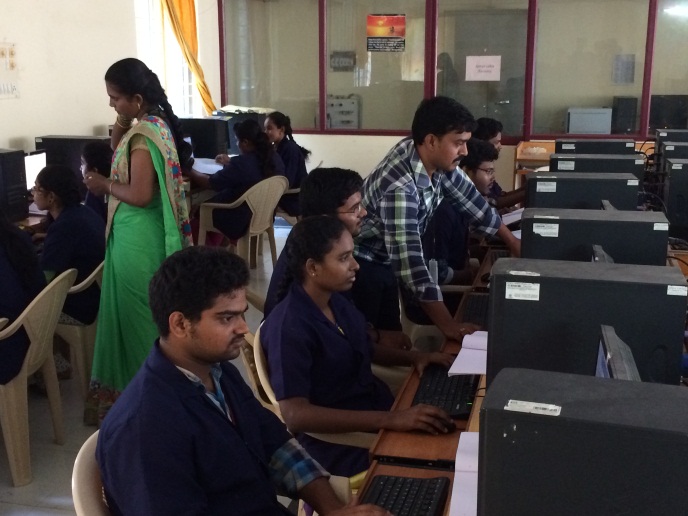
VLSI Lab:
The main objective of this lab is to provide an overview of the schematic and layout parasitic extraction of basic circuits like Inverter,NAND,NOR etc., It also deals with implementing various sequential and combinational circuits in Verilog and VHDL.
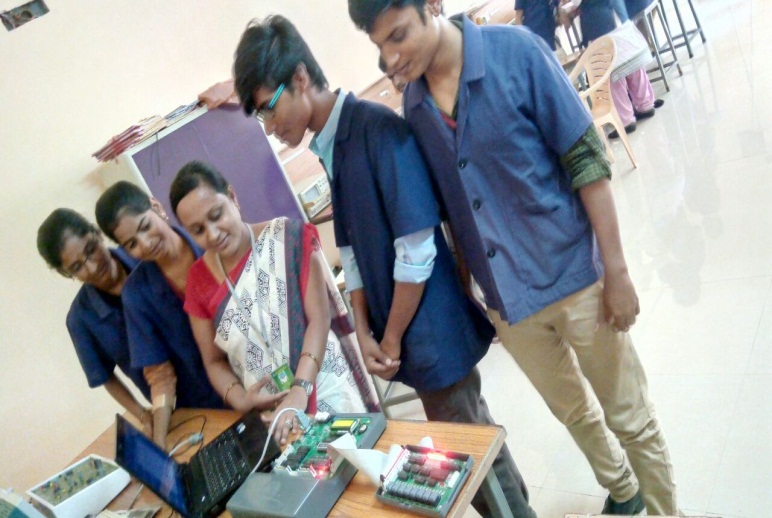
Microprocessors and Microcontrollers Lab:
This lab gives the idea of microprocessors like 8085, 8086 to the students. In this lab, the students are trained to write the programs for different manipulations with the microprocessors using TASM. This lab is also useful for the students to know the interfacing of the microprocessors to different applications like display, rotating motors, etc.
ECE FACULTY LIST
| S.No | Name | Qualification | Designation | Date Of Joining | Specialization |
|---|
IN PROGRESS
FACULTY PUBLICATION DETAILS
| S.No. | Author | Title | NAME OF JOURNAL | VOLUME & PP |
|---|---|---|---|---|
| 1. | Dr. S.Sivanandam | Fingerprint biometric and GPS enabled Travel fare deduction system for Indian Railways | IJPAM | Volume 119 & 151-158 |
| 2. | A.J.Reuben Thomas Raj | Aadhar Based Airport/Passport Entry System | IJSRP | Vol.8 & 243-247 |
| 3. | A.J.Reuben Thomas Raj &B.Silpa | Automatic car driving system for handicapped and Polio-Persons with a scooter handle | IJARIIT | Vol.8 & 1116-1119 |
| 4. | S.Sandeep | Monitoring of Health Parameters by Using Raspberry Pi | IJARCSSE | Vol.4 & 367-372 |
| 5 | S.Sivanandam | Design and simulation of bionic glove for rehabilitation of the paralytics | IJET | Vol.7 & 1-66 |
| 6. | M.Sivalingamaiah | IOT Based Intelligent Healthcare Kit | IJSR | Vol.7&204-2077 |
| 7. | M.Gopal | Complexity Reduced Antenna Selection Technique for MIMO Communication System | IJPAM | Vol.1 & 323-326 |
| 8. | S.Sandeep | IOT Based Automatic Irrigation System | IJGSE | Vol.5 & 5-11 |
| 9. | S.Sandeep | An Optimal Energy Monitoring System Using Internet Of Things (IOT) | IJGSE | Vol.5 & 38-43 |
| 10. | G. Sailaja & P.Gayathri | Automatic Pantry Order System using Wi-Fi | IJIACS | Vol.6 & 532-536 |
| 11. | M.Sivalingamaiah, E.Satheesh Kumar & M.Vijaya Lakshmi | RFID Based Student Monitoring And No Due Status Checking | IJIRAS | Vol.3,41-44 |
| 12. | M.Sivalingamaiah, E.Satheesh Kumar & M.Vijaya Lakshmi | Solar Based E – Uniform For Soldiers-Used For Temperature Control And Tracking | IJERD | Vol.2,49-53 |
| 13. | P.Gayathri | Modeling & Analysis of Cost Effective Lemon Harvesting Robot S. | IJAER | Vol.10, 9697-9710 |
| 14. | J.Ravi kumar | Purpose of Low-Power Linear Feedback Shift Register (LFSR) by using Bipartite and Random Injection Method for Low Power BIST | IJISET | Vol.2, 713-720 |
| 15. | Dr. P.Subbaiah | Tuning and Analysis of Multiple Interactive Loop Process by Model Predictive Control | IJET | Volume-3, Issue-2 |
| 16. | Dr. P.Subbaiah | Tuning of Nonlinear Model Predictive Control for Quadruple Tank Process | IJTAIT | Vol. 51 No.3 |
| 17. | Dr. P.Subbaiah | High Speed Charging and Discharging Current Controller Circuit to Reduce Back emf by Neuro Fuzzy Logic. | IJAER | Volume 9 pp. 12949-12960 |
| 18. | Dr. P.Subbaiah | Rotor Position Of Switched Reluctance Motor Using Sensorless Method | IJTAIT | Vol. 70 No. 6 |
| 19. | Dr. P.Subbaiah | Design Implementation and Hardware Structure for Image Enhancement and Surface Roughness with Feature Extraction Using Discrete Wavelet Transform | JCSSP | VOL.5 ,347-352e |
| 20. | Dr. P.Subbaiah | Neural Model For Image Enhancement Using Discrete Wavelet Transform | IJEEDC | Volume – 1, Issue – 16-21 |
| 21. | Dr. P.Subbaiah | Energy management scheme with load balancing for Preemptive Dynamic source routing protocol for MANET | IJTAIT | Vol. 51 No.3 |
| 22. | Dr. P.Subbaiah | Non Linear Image Processing With Evolvable Hardware Filter | IJAR | volume-3, 58-61 |
| 23. | Dr. P.Subbaiah | Centralized and Decentralized of Quadruple Tank Process | IJCA | Volume-4, Issue-3 |
| 24. | Dr. P.Subbaiah | Mobility scenario-based Performance Evaluation of Preemptive DSR Protocol for MANET | WSEAS transactions on communications | Volume 12 |
| 25. | Dr. P.Subbaiah | Integrated Noise Removal Filter for Switched Reluctance Motor | JCA | Volume 65– No.14, |
| 26. | Dr. P.Subbaiah | SURFACE ROUGHNESS PREDICTION WITH DENOISING USING WAVELET FILTER. | IJAET | Volume-3, Issue-2 |
| 27. | Dr. P.Subbaiah | Linear and Nonlinear Model Predictive Control of Quadruple Tank Process | IJCA | Vol. 31 No.4 |
IPR DETAILS
STUDENT INNOVATIONS
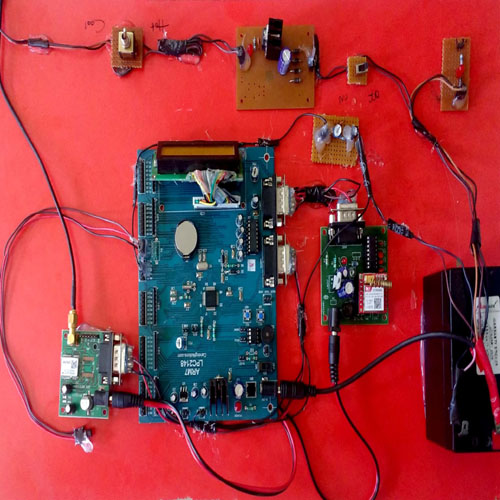
IOT Based Intelligent Healthcare kit.
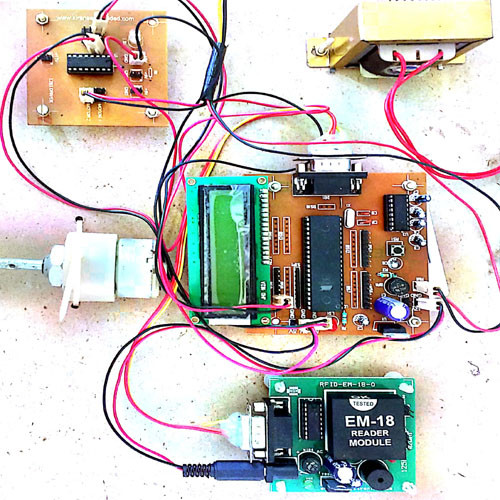
Cell-phone Based Land Rover
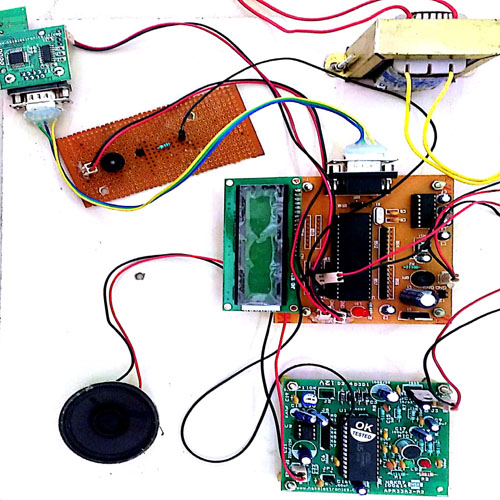
Vision based product Label text reading for Blind persons
STUDENT ACHEIVEMENTS
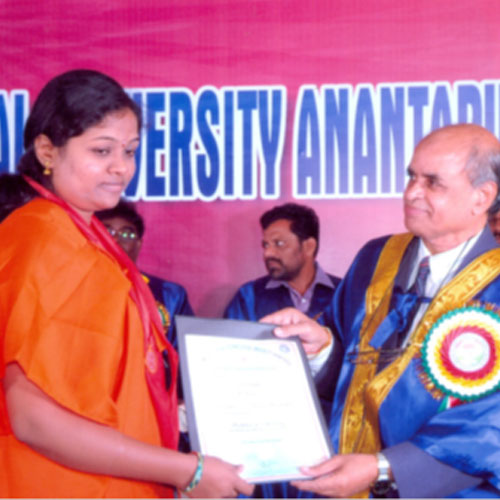
R. Kiranmayee is the Topper of the JNT University Anantapur facilitated with Gold medal in JNT university on the hands of Dr.Lal Kishore, Vice Chancellor, JNTUA, Ananthapur.
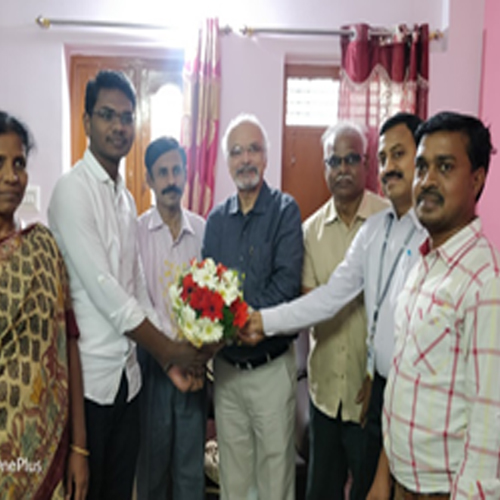
T.Thulasidhar of 2011-15 Batch has secured All India 73rd Rank in Indian Engineering Service(IES).
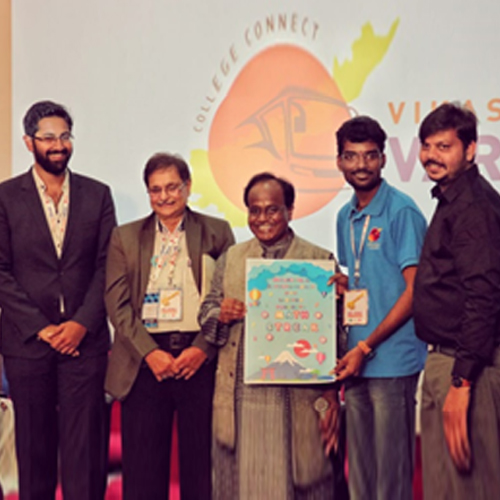
Our Student Dharshan Kumar of 2015-19 Batch is one among the Startup Group in developing the game named Math Streak released under Skylark Educraft, an incorporation of Wherewithal Pvt Ltd in 2019.
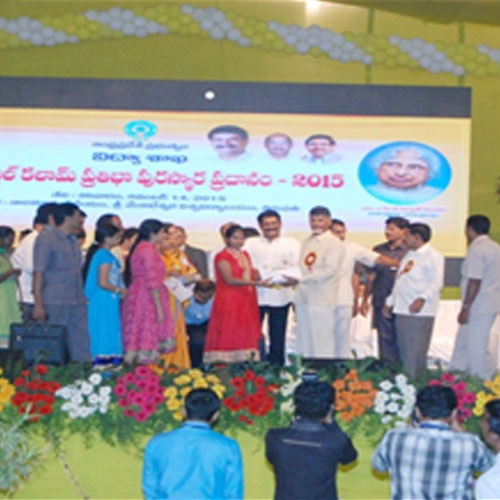
P. Prathima has awarded Prathiba Award by the Government of Andhra Pradesh for her.
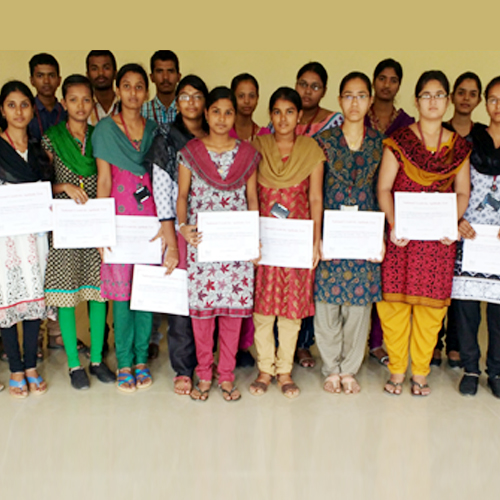
Our Students has Participated and showed merit in National Creativity Aptitude Test . One of our Student, B. SUDHEER has secured all India 75.9 percentile.
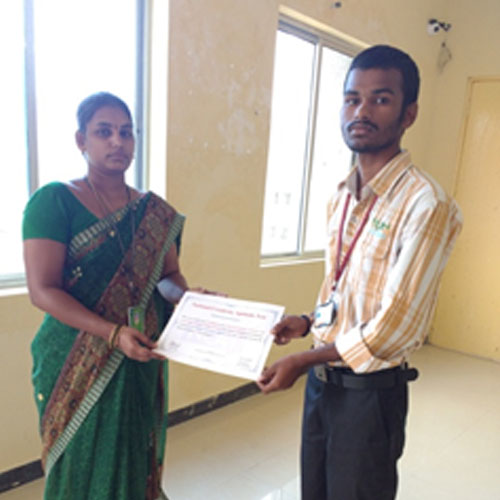
Our Students has Participated and showed merit in National Creativity Aptitude Test . One of our Student, B. SUDHEER has secured all India 75.9 percentile.
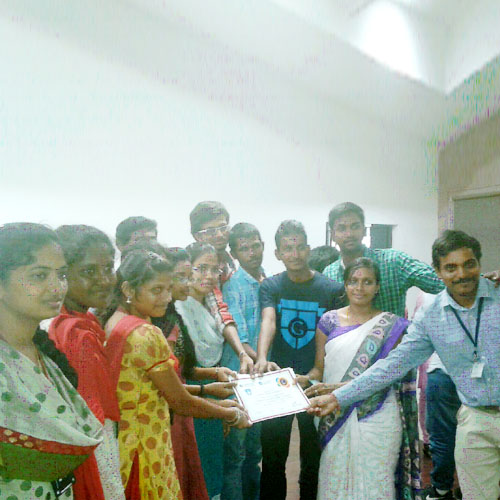
Students has participated in App designing Workshop named Design Sprint and won the best App developer Group in Saveetha University, Chennai on 05-08-2015
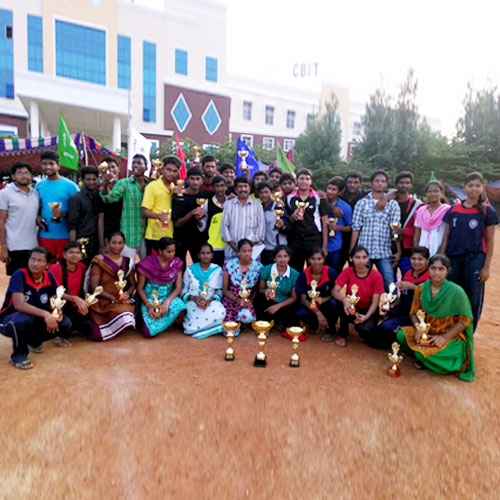
Our students M. Mounica and P. Mrudhuvani are runners in Basketball Championship in 6th JNTUA Inter college Games Meet in CBIT/VBIT, Prodhutur.
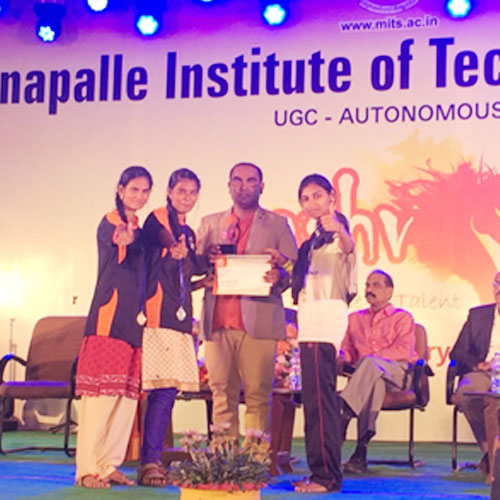
Our students P. Mrudhuvani and S. Srujana are Winners in Throwball in ASHV2K17 in MITS, Madhanapalli.
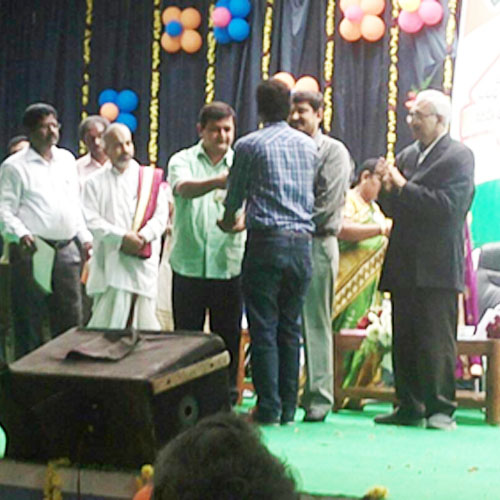
Our Student B. Vamsi Krishna got first prize in District Painting Competition.
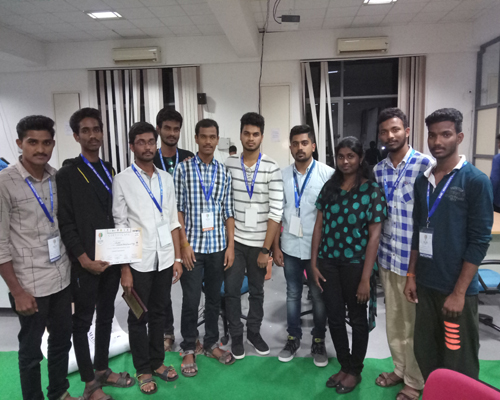
NIT Warangal conducted SMART INDIA HACKATHON - 2019 (SIH - 2019) on 2nd & 3rd march 2019. In SIH, 8 different problem statements has been given to 200 students.
Among the 8 batches, the students batch from our college (ECE DEPT, SISTK) got selected and given with 50,000/- cash prize.